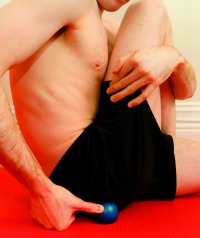There
is a common claim in a physiotherapy practice: “It’s my hamstring, it’s tight
and will not let go – just at the top.”
Other
remarks are: “My leg does not come through very well” or “It’s like running in
treacle!”
The main reason for this is a problem in the pelvis and the sacroiliac (SI) joint. The pelvis is made up of three bones – the sacrum in the middle and an ileum on each side. The SI joint is found at the back where the two iliums attach on to either side of the sacrum. It is unusual in that it is two irregular surfaces of bone that are held together by a thick fibrous skirt.
There is little motion, five degrees maybe, as the leg comes from behind to in front. However, it is the top end of a long lever, the leg. Physics tells us that a small amount of motion at one end of a lever has a large e?ect at the other. If the SI joint becomes jammed and does not move the effects on the leg are dramatic.
Main symptoms
» Tightness in the upper hamstring
» Tightness in the gluteal or buttock region
» Possible soreness in the lower back, but not often
The history is often not clear. There is rarely an ‘ouch’ moment. However, episodes in my experience are often caused by:
» Fast downhill running
» Running with a poor core and the pelvis tipping forwards
» Lack of form at the end of a hard session
» A hard stumble or trip
Self-assessment
This is always difficult. Your physio should look at the pelvis motion with bending forwards and sideways and then with single leg lifts – knee to chest. They should be looking at the back of the pelvis and noting how the bones move.
There is often an ‘apparent’ leg length discrepancy – tested in lying and sitting. This is often confused with an ‘actual’ leg length change and I have seen many athletes with heel wedges put in place for what is a normal leg length. This does not help.
There
are 24-odd different types of pelvis dysfunctions and you need to be
experienced to diagnose them properly. There is, however, a very common dysfunction
seen in runners. This is where the ileum (the outside bone) becomes rotated
forward on the sacrum (the central bone). It is too subtle to describe in an
article like this and requires an experienced physio to diagnose.
The majority of these problems require mobilisation of the SI joint by a physio who is used to dealing with runners. This is done by side lying or on your back and usually involves pressure through the pelvis with the knee towards the chest. There are several ways to do it though, and the following exercises are designed to help this condition. They will not hurt you if it is not the problem. Try them for a few days and if there is no improvement then seek help. Once the pelvis has been mobilised follow the instructions given by your physio which will be similar to these exercises.

Hug
your knee to your chest and hold tight around the knee (as above). Push hard with
your leg into your hands for 10 seconds, then relax, pull it tight again and
repeat. The pressure comes from your hip and bum. You are not straightening the
knee. This can be done sitting or lying and needs to be repeated hourly about
15 times. The object is to use your bum muscles to mobilise the sacroiliac
joint. You will not feel much apart from strain in the bum.
When sitting, cross the foot of the hip to be stretched to the outer side of the other knee (see below). Hug the bent knee with the opposite hand (so if it is your right hip to be stretched, put the right foot to the left of the left knee and hug the right knee with your left arm).

Place
a tennis ball or hard cricket/hockey/dog ball in the buttock and lean towards
it. Fiddle with the exact position, somewhere between the outer hip bone and
the bone you sit on.
Look for the most painful spot and then work the ball into it for a couple of minutes. The object is to loosen the deep gluteal muscles which go into spasm whenever there is a sacroiliac joint dysfunction.

The
image above shows the direction to bend –away from the symptomatic side.
You are more effective if you hold your core in really tight, tipping the
pelvis backwards. This focuses the stretch into the area of the back – 45
seconds, three times and several times a day.
Using a roller or a can, roll on the upper hamstring through the tight areas, keeping the back as straight as possible – two minutes, three times a day.
Can I run?
This
is the big question, and the answer is yes! Running actually helps to mobilise
a sacroiliac joint once it is moving properly, if it is not, then it will
irritate it.
Try the above, but if in doubt, please seek help. These conditions can linger for many months undiagnosed and are simple to treat.
http://www.athleticsweekly.com/coaching/the-pelvis-a-joint-problem/#e1rLCabf2dXsLUZh.99

